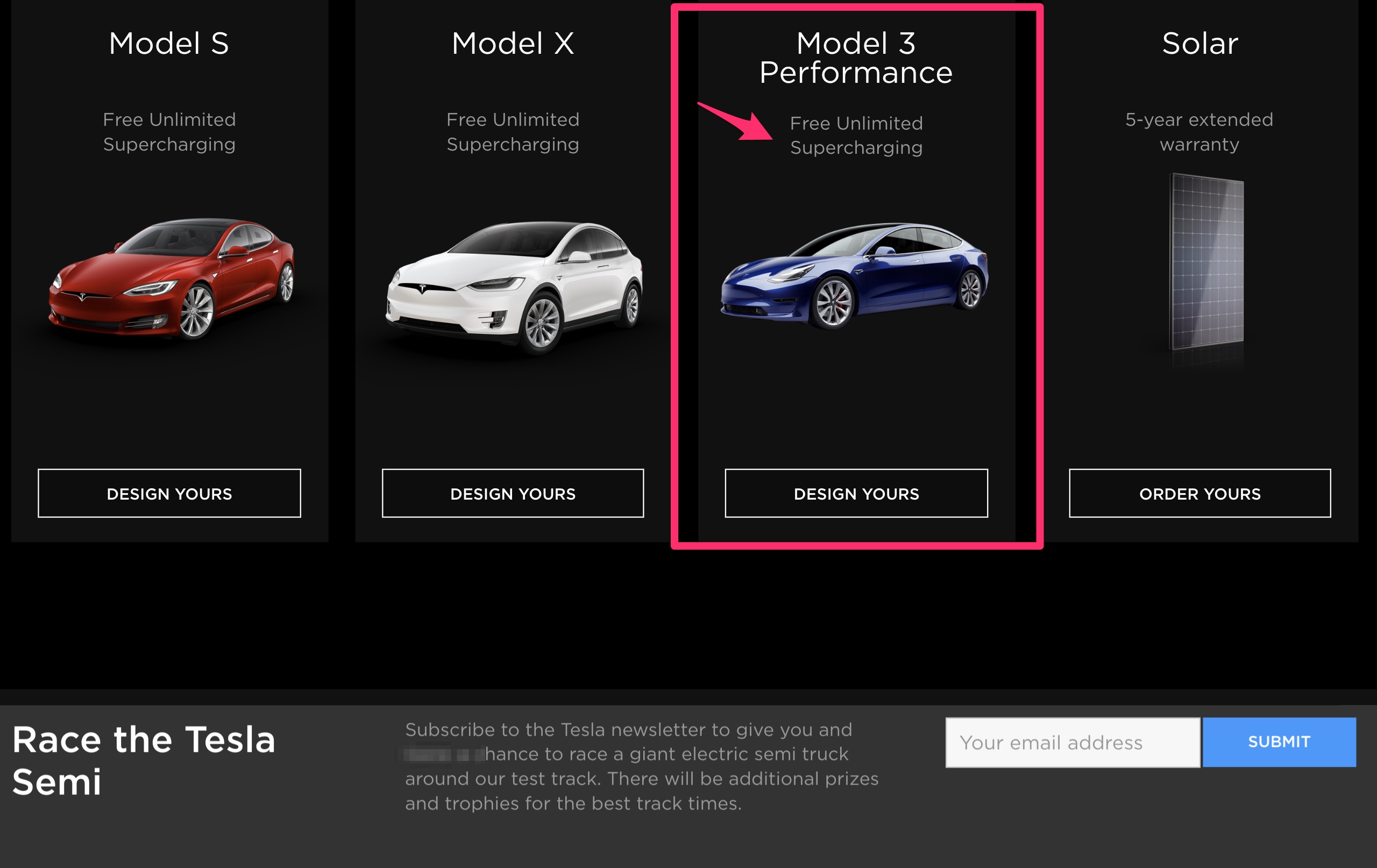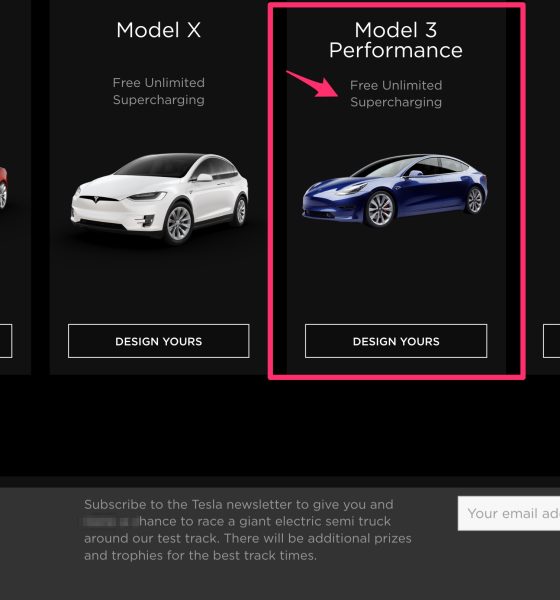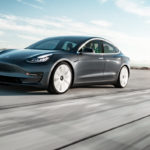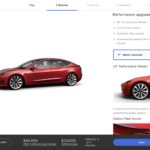

News
Tesla offers Model 3 Performance buyers free unlimited Supercharging in latest referral program update
Tesla has updated the details for its latest Referral Program to include Model 3 Performance as a vehicle that’s eligible for incentives when purchased through a referral code. In addition, Tesla has extended free unlimited Supercharging to Model S and Model X purchases made between August 1 and September 16, which also includes Model 3 Performance.
With a new Referral Program in place, owners can give five of their referrals free unlimited Supercharging with the purchase of a Model S, Model X, or Model 3 Performance. Vehicles purchased before September 16 would enjoy the full, unlimited fast-charging perk for the lifetime of the vehicle under its original ownership. After September 16, Tesla would be limiting unlimited Supercharging to one year for the Model S, Model X, and Model 3 Performance. The limits of the new Referral Program also indicate that all Model 3 Performance orders placed before August 1, 2018 would be given unlimited Supercharging, including vehicles not purchased through a referral code. This is the first time Model 3 buyers are being offered free use of the company’s global network of Superchargers.
Tesla has been rolling out a Referral Program for Model 3 owners over the past few months, though some owners were only able to receive their referral codes recently. Ultimately, the updated Referral Program features benefits designed specifically for the growing Model 3 community, but it also comes with a time limit. If the company does follow through and retires the program after September 16, it will only be a matter of time before new owners of Tesla’s vehicles, including its flagship Model S and X, would have to pay for Supercharging.
- The Tesla Model 3 is establishing itself as a formidable competitor in the US passenger car market. [Credit: Tesla]
Tesla’s introduction of rewards directly linked to the Model 3 Performance appears to be the electric car maker’s latest way of upselling the vehicle to reservation holders. Considering that the company is pushing for profitability this third quarter, every order of the Model 3 Performance, which starts at $64,000, would likely help Tesla become profitable this Q3. The Model 3, after all, has been found to the profitable, with a recent teardown and analysis of the vehicle from Detroit veteran Sandy Munro revealing that the electric car’s Long Range RWD variant exceeds 30% profit. The Model 3 Performance, being priced higher, would most likely give Tesla even more.
Apart from the introduction of free unlimited Supercharging to the Model 3 Performance, Tesla’s updated Referral Program still features much of the same perks as before. The following is a breakdown of referral awards for participating Tesla owners.
1 to 2 Qualifying Referrals
- Signature Black Wall Connector – This item is only available under the Referral Program. Shipping started in July 2018.
- Founders Series Tesla Model S for Kids – This item is a miniature version of the Tesla Model S, complete with working headlights, a sound system, and even a working charge port. Anecdotes from the Tesla community note that the large box of the Model S for Kids fits perfectly at the back of the family sedan with the rear seats folded down.
3 Qualifying Referrals
- Early Access Token for Solar Roof – Customers who opt for this perk would get early access and priority scheduling for Solar Roof installations, which already begun earlier this year. This perk could be given to a friend.
4 Qualifying Referrals
- 21” Arachnid Wheels for Model S or 22” Turbine Wheels for Model X — Wheels designed to improve the performance of the Model S and X.
- One Week with Model S or Model X – The Teslas used for this perk could be used on a road trip. Customers who opt to not use this reward can give this to a friend.
5 Qualifying Referrals
- Tesla Unveiling Invitation – Owners who reach five referral orders will be invited to a future unveiling event. The VIP invitation is valid for the Tesla owner and one guest.
- Founders Series Powerwall 2 – This home battery storage unit features a unique red color scheme.
Tesla is also extending its Race an Electric Semi Truck referral award. Just like before, the person who can get the most number of friends to sign up for Tesla’s newsletter would have the opportunity to race the Tesla Semi around the company’s test track.
Referral rewards for Tesla Solar have also been extended with the updated program. Owners could give their referrals a 5-year extended limited warranty on new solar energy system installations. One to four qualifying referrals would give Tesla owners $400 cash of $750 credit per installed referrals. Five qualifying referrals gives owners a free Founders Series Powerwall 2 battery.

Elon Musk
Elon Musk and Tesla AI Director share insights after empty driver seat Robotaxi rides
The executives’ unoccupied tests hint at the rapid progress of Tesla’s unsupervised Robotaxi efforts.

Tesla CEO Elon Musk and AI Director Ashok Elluswamy celebrated Christmas Eve by sharing personal experiences with Robotaxi vehicles that had no safety monitor or occupant in the driver’s seat. Musk described the system’s “perfect driving” around Austin, while Elluswamy posted video from the back seat, calling it “an amazing experience.”
The executives’ unoccupied tests hint at the rapid progress of Tesla’s unsupervised Robotaxi efforts.
Elon and Ashok’s firsthand Robotaxi insights
Prior to Musk and the Tesla AI Director’s posts, sightings of unmanned Teslas navigating public roads were widely shared on social media. One such vehicle was spotted in Austin, Texas, which Elon Musk acknowleged by stating that “Testing is underway with no occupants in the car.”
Based on his Christmas Eve post, Musk seemed to have tested an unmanned Tesla himself. “A Tesla with no safety monitor in the car and me sitting in the passenger seat took me all around Austin on Sunday with perfect driving,” Musk wrote in his post.
Elluswamy responded with a 2-minute video showing himself in the rear of an unmanned Tesla. The video featured the vehicle’s empty front seats, as well as its smooth handling through real-world traffic. He captioned his video with the words, “It’s an amazing experience!”
Towards Unsupervised operations
During an xAI Hackathon earlier this month, Elon Musk mentioned that Tesla owed be removing Safety Monitors from its Robotaxis in Austin in just three weeks. “Unsupervised is pretty much solved at this point. So there will be Tesla Robotaxis operating in Austin with no one in them. Not even anyone in the passenger seat in about three weeks,” he said. Musk echoed similar estimates at the 2025 Annual Shareholder Meeting and the Q3 2025 earnings call.
Considering the insights that were posted Musk and Elluswamy, it does appear that Tesla is working hard towards operating its Robotaxis with no safety monitors. This is quite impressive considering that the service was launched just earlier this year.
Elon Musk
Starlink passes 9 million active customers just weeks after hitting 8 million
The milestone highlights the accelerating growth of Starlink, which has now been adding over 20,000 new users per day.

SpaceX’s Starlink satellite internet service has continued its rapid global expansion, surpassing 9 million active customers just weeks after crossing the 8 million mark.
The milestone highlights the accelerating growth of Starlink, which has now been adding over 20,000 new users per day.
9 million customers
In a post on X, SpaceX stated that Starlink now serves over 9 million active users across 155 countries, territories, and markets. The company reached 8 million customers in early November, meaning it added roughly 1 million subscribers in under seven weeks, or about 21,275 new users on average per day.
“Starlink is connecting more than 9M active customers with high-speed internet across 155 countries, territories, and many other markets,” Starlink wrote in a post on its official X account. SpaceX President Gwynne Shotwell also celebrated the milestone on X. “A huge thank you to all of our customers and congrats to the Starlink team for such an incredible product,” she wrote.
That growth rate reflects both rising demand for broadband in underserved regions and Starlink’s expanding satellite constellation, which now includes more than 9,000 low-Earth-orbit satellites designed to deliver high-speed, low-latency internet worldwide.
Starlink’s momentum
Starlink’s momentum has been building up. SpaceX reported 4.6 million Starlink customers in December 2024, followed by 7 million by August 2025, and 8 million customers in November. Independent data also suggests Starlink usage is rising sharply, with Cloudflare reporting that global web traffic from Starlink users more than doubled in 2025, as noted in an Insider report.
Starlink’s momentum is increasingly tied to SpaceX’s broader financial outlook. Elon Musk has said the satellite network is “by far” the company’s largest revenue driver, and reports suggest SpaceX may be positioning itself for an initial public offering as soon as next year, with valuations estimated as high as $1.5 trillion. Musk has also suggested in the past that Starlink could have its own IPO in the future.
News
NVIDIA Director of Robotics: Tesla FSD v14 is the first AI to pass the “Physical Turing Test”
After testing FSD v14, Fan stated that his experience with FSD felt magical at first, but it soon started to feel like a routine.

NVIDIA Director of Robotics Jim Fan has praised Tesla’s Full Self-Driving (Supervised) v14 as the first AI to pass what he described as a “Physical Turing Test.”
After testing FSD v14, Fan stated that his experience with FSD felt magical at first, but it soon started to feel like a routine. And just like smartphones today, removing it now would “actively hurt.”
Jim Fan’s hands-on FSD v14 impressions
Fan, a leading researcher in embodied AI who is currently solving Physical AI at NVIDIA and spearheading the company’s Project GR00T initiative, noted that he actually was late to the Tesla game. He was, however, one of the first to try out FSD v14.
“I was very late to own a Tesla but among the earliest to try out FSD v14. It’s perhaps the first time I experience an AI that passes the Physical Turing Test: after a long day at work, you press a button, lay back, and couldn’t tell if a neural net or a human drove you home,” Fan wrote in a post on X.
Fan added: “Despite knowing exactly how robot learning works, I still find it magical watching the steering wheel turn by itself. First it feels surreal, next it becomes routine. Then, like the smartphone, taking it away actively hurts. This is how humanity gets rewired and glued to god-like technologies.”
The Physical Turing Test
The original Turing Test was conceived by Alan Turing in 1950, and it was aimed at determining if a machine could exhibit behavior that is equivalent to or indistinguishable from a human. By focusing on text-based conversations, the original Turing Test set a high bar for natural language processing and machine learning.
This test has been passed by today’s large language models. However, the capability to converse in a humanlike manner is a completely different challenge from performing real-world problem-solving or physical interactions. Thus, Fan introduced the Physical Turing Test, which challenges AI systems to demonstrate intelligence through physical actions.
Based on Fan’s comments, Tesla has demonstrated these intelligent physical actions with FSD v14. Elon Musk agreed with the NVIDIA executive, stating in a post on X that with FSD v14, “you can sense the sentience maturing.” Musk also praised Tesla AI, calling it the best “real-world AI” today.











